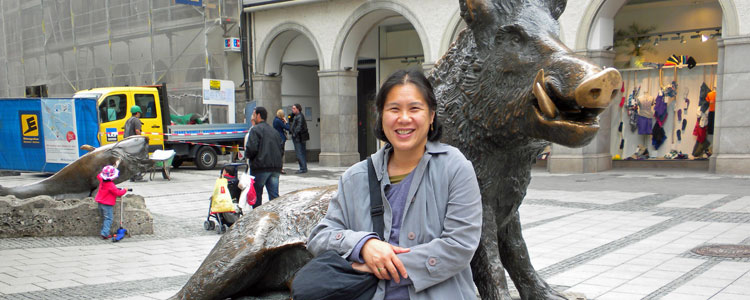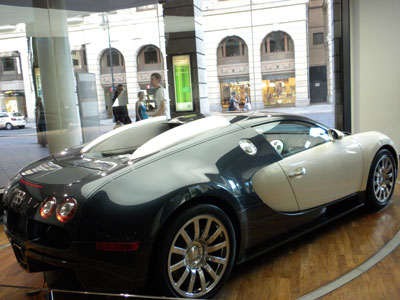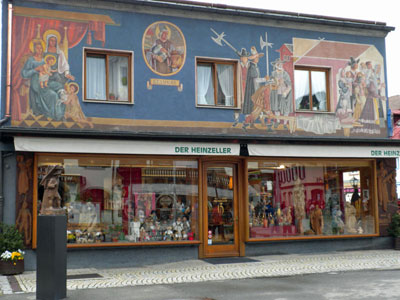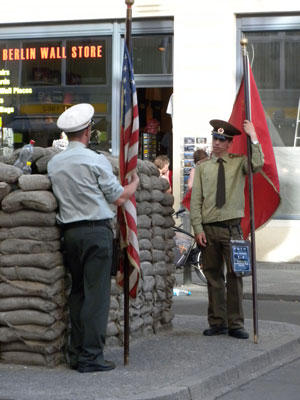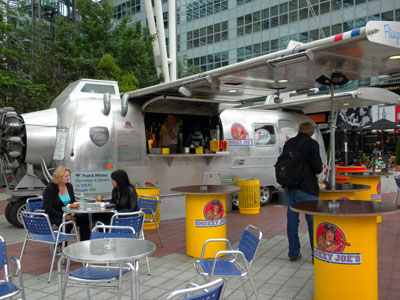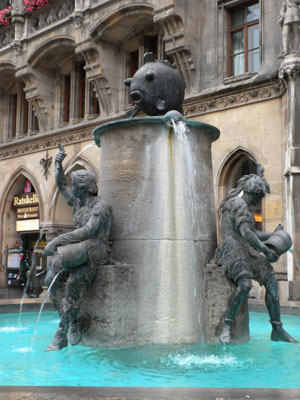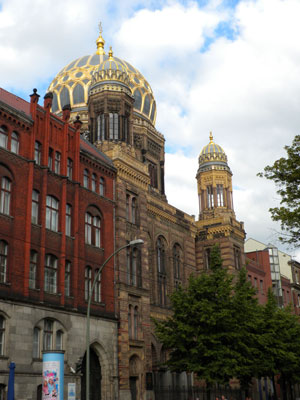Berlin, Munich & Oberammergau: Sampling the sights and tastes of Germany
by Dorothy Chang-Van Horn; Manhattan Beach, CA
My niece, Dorothy, and I used our American Airlines frequent-flyer miles to book a business-class flight to Berlin. We were scheduled to fly from LAX to JFK on June 11, 2010, continuing with Iberia to Madrid and on to Berlin. However, those plans were drastically altered when I received a phone call from American Airlines early the morning before, informing me that our flight was canceled due to equipment failure!
After reviewing several options, we chose a flight departing that night at 11:20.
I called Alex of Cheap Shuttle (310/641-1199 or 310/908-9975), whom I’ve used for over eight years when flying out of LAX ($20, not including tip), to change my transfer reservation.
Getting settled
After two long days of waiting for our flight connections in first- and business-class lounges, we finally arrived at Berlin Tegel Airport, taking a taxi (€20, or $27.50, including tip) to Hotel Agon Lichtburg (Paderborner Strasse 10; phone +49 30 8902 940).
Our elevator stopped at the sixth floor, and we wearily carried our bags to our rooms on the nonsmoking seventh floor. I was disappointed when I saw my dinky, dreary room.
On a visit to Berlin five years prior I had stayed at Hotel Agon Frankfurter Allee (Scharnweberstrasse 21-22; phone +49 30 297777 0), and its accommodations were excellent, comfortable and clean. That was not so at Hotel Agon Lichtburg.
My niece was afraid I would fall while stepping over the “speed bumps” in the dark hallway to my room. The hallway’s light bulb had burnt out and had not been replaced. In addition, my shower had a high step and no grab bars.
After checking the state of her room, Dorothy reported that the fabric headboard of her bed and the room’s carpet were worn and dirty and her mattress was sunken in. Both rooms were extremely hot.
The rate was low (a single, €62.50, or $86, plus €4.50 for the buffet breakfast), but we decided that we’d be miserable spending another five nights at Hotel “Agony,” so we trekked along Kufürstendamm the next day hoping for better accommodations.
We stumbled into Hotel Mondial (Kurfürstendamm 47; phone +49 30 884 11 0), where we met a very accommodating desk clerk, Patrick Hepke. We said that we needed two rooms for five nights.
I requested a handicap accessible room, as I had fractured my left knee two months earlier and most European bathtubs and showers have high lips and no grab bars.
Patrick found two single, nonsmoking, handicap accessible rooms. Although my niece didn’t need a room equipped for the disabled, its special features and roominess were most welcome.
Before returning to Hotel Agon for that night, we treated ourselves to Berlin’s famous Currywurst (€3) at a stand Patrick recommended, located across the street from Hotel Mondial.
My room at the four-star Hotel Mondial was worth the special rate of €550 for five nights (plus €50 for daily breakfast). The rooms were spacious, each furnished with a comfortable queen-sized bed, two leather armchairs, a spic-and-span bathroom with no step up into the shower, a mini-bar, a desk, a TV, an armoire and free WiFi.
Best of all, we were located just blocks from the Uhlandstrasse subway station, and the Zoological Garden, the aquarium and excellent restaurants were within walking distance.
We each purchased a CityTourCard for five days (€29), which provided public transportation throughout the city center and discounts at museums and the zoo.
Seeing the city
During our five days in Berlin, I referred to Fodor’s slim, pocketbook-size “Berlin’s 25 Best” for suggestions on what to see, where to go and what to do. Invaluable were its S- and U-Bahn maps, sectional street maps, pull-out map, essential facts and basic language sections.
We toured Brandenburger Tor, Checkpoint Charlie and the Berlin Wall Museum (Friedrichstrasse 43-44), which displayed ingenious methods used to escape over the Wall.
Lunch was at Augustiner am Gendarmenmarkt, Mitte (Charlottenstrasse 55; phone +49 3020 45 40 20), where I paid €10, including the service charge, for a pair of Augustiner Bavarian sausages, or Weisswurst, with sweet mustard, bread and beer. Yum!
After lunch we walked to Gendarmenmarkt to visit its Konzerthaus, designed by Karl Friedrich Schinkel in 1821. At the opposite end of the square are the twin French and German cathedrals: the Französischer and Deutscher Doms.
After viewing the sights of Unter den Linden, we went to a charming restaurant I had noticed earlier near the S-Bahn station, Zillemarkt (Bleibtreustrasse 48a; phone +49 30 881 7040), for dinner.
Diners in the garden were watching the World Cup while I dined on one of my favorite German entreés, Eisbein, the lower part of a smoked pork hock which is boiled for a long time. Tangy sauerkraut and mustard accompanied the succulent, tender hock (€11.50). For my beverage, I chose the house specialty, a hoppy Zillebräu Pils (€2.30).
Much to the glee of the Germans seated behind me, I managed to finish the huge hock with gusto. I highly recommend dining here, either in the lovely garden or indoors in the charming Bavarian atmosphere.
Seeing the sights
The next day we decided to visit Mauerpark, which served as the location for the Old Nordbahnhof/Northern Railway Station during the 19th and 20th centuries. Unfortunately, we did not have a handheld GPS to direct us to our destination, so we stopped frequently along the way, asking friendly, helpful Berliners for directions.
We finally located Mauerpark, one of several green spaces in Berlin. After the Berlin Wall was built, this area was in the heavily guarded Death Strip. When the Wall fell, in 1989, it was designated a public park. We walked along the 30-meter strip of the Berlin Wall which stands in the park as a monument.
While walking along Friedrichstrasse, at the corner of Unter den Linden, we were lured into Volkswagen’s flagship automobile museum (Automobilforum) by the stunning Bugatti in its window. Also on display was a wide selection of automobiles, from practical Skodas to opulent Bentleys, and, of course, all of the VW classics.
On Dorothy’s “to see” list was the Neues Museum on Berlin’s Museum Island. The museum’s collection of 2,000 ancient artifacts spans three millennia. Among the popular attractions is the iconic, limestone bust of Nefertiti, the Egyptian queen.
On our way to the S-Bahn on Oranienburger Strasse, we stopped at the Neue Synagoge (New Synagogue) with its stunning dome, one of Berlin’s landmarks. Destroyed during WWII, the synagogue wasn’t rebuilt until after the fall of the Berlin Wall.
Next we took the U-Bahn to Kreuzberg, a multiethnic working class community with a large population of Turks, and got off at Kottbusser Tor. We walked to that evening’s restaurant, Hasir Kreuzberg (Adalbertstrasse 10; phone +49 30 614 23 73).
My meal of grilled lamb on skewers with a pilsner cost around €12.25. In Germany, the service charge is always included in the tariff. This is in lieu of a 15%-20% tip. However, it is customary to round up the bill, in this case, tipping €0.75 — or more, if you wish.
The zoo and more
During my previous three visits to Berlin, I missed seeing the oldest zoo in Germany, the Zoological Garden. The zoo opened in 1844, when the King of Prussia, Friedrich Wilhelm IV, donated his gardens and exotic-animal collection to the city of Berlin. Today about 16,000 animals — 1,500 species — roam in open enclosures on 84 acres
Conveniently, Hotel Mondial is only two U-Bahn stops away. With the city card, the entrance fee was €10.80.
We also visited Berlin’s aquarium, known for its extensive biodiversity. More than 9,000 animals are on display, including tropical and native fish, a variety of insects and an extensive collection of colorful amphibians and reptiles. Entry cost €6. There was no discount with our city card.
Our dinner that evening was exceptional. A couple of blocks from our S-Bahn station, we discovered a street with a treasure trove of ethnic restaurants. Each of their posted menus was tempting. Finally, we decided on Shanghai (Kantstrasse 22; phone +49 30 670 333 54) and were not disappointed.
Noticing a table of diners enjoying a hot pot, Tai Pin Lo, we couldn’t resist doing likewise. Dorothy claims we ate enough for four people.
The dish we were served was made in the Yunnan tradition, with bubbling chicken broth on one side of the divided pot and a piquant, spicy broth on the other. A large variety of cooked meats, fish and vegetables was available for dipping into the accompanying sauces.
Our exquisite meal for two cost only €43, or $59, including two large bottles of beer.
Another item on my niece’s list of “must sees” was Hackesche Höfe (just off S-Bahn Station Hackescher Markt), located in the Scheunenviertel and close to Alexanderplatz. This maze of eight restored courtyards forms one large complex for living and working, the largest of its type in Germany.
Accessible through the main arched entrance at Rosenthalerstrasse 40, the complex of colorful buildings is a mixture of offices, workshops, apartments, multistory factories, cabarets, cinemas, bars and restaurants.
We sipped coffee and tea while watching the vibrant activity in the quarter.
Nearby is Grosse Hamburger Strasse 26, the location of Berlin’s oldest cemetery, Alter Jüdischer Friedhof, used between 1672 and 1827. In 1943 the Gestapo destroyed the cemetery, using tombstones to reinforce the walls of air raid shelters built over the desecrated graves. After the defeat of the Nazis in 1945, the area was turned into a park.
We saw a few broken Baroque gravestones near the remaining cemetery wall. Near the entrance was one single, symbolically marked grave dedicated to Germany’s greatest philosopher, Moses Mendelssohn.
On to Munich
We departed Berlin Tegel Airport on Airberlin and headed to our next stop, Munich. Boarding the plane, we were surprised to find that all three seats of the third row had been reserved for us. Passengers requesting wheelchair assistance are assigned that special row.
Our one-hour, 10-minute flight was booked online at CheapOAir.com. Our nonrefundable tickets cost $92.60 per person, including taxes and fees, plus we received a $10 incentive for our next reservation with them.
Arriving at Flughafen München-Franz Josef Strauss, we purchased a two-day CityTourCard (€29) from a machine near the elevators for the S-Bahn. After punching our ticket in the blue punch machine (labeled “Entwerter”) on the platform, we boarded the train for the 45-minute ride to Marienplatz, the heart of Old Town. (Without the card, a single journey costs €10.)
As we departed the train, I was stymied by the steep escalator from the S-Bahn to street level, which was immobile. My spry niece had no problem climbing the stairs into the pouring rain to hail a cab, but I struggled upward with my two carry-on bags. That’s when I met an angel in Munich. Without hesitation, she kindly took my cumbersome wheelie and effortlessly carried it up to where my niece was waiting.
Finding a cab in the downpour was as daunting as the steep steps. After finally hailing one, we arrived at Holiday Inn Munich-South (Kistlerhofstrasse 142; phone +49 89 78 0020 or, in the US, 888/465-4329).
Our room for two nights was included in the Passion Play package we had booked with Gate 1 Travel (Ft. Washington, PA; 800/682-3333). The total package cost for two, sharing a room, was $1,730.
The five-day package also included excellent seats for the Passion Play in Oberammergau; round-trip transfers from Munich to our hotel in Garmisch-Partenkirchen; two buffet breakfasts and a buffet lunch at Holiday Inn Munich-South; an excellent dinner in Garmisch at Hotel Arnika, and a buffet breakfast at Hotel Garmischer Hof.
At the Holiday Inn Munich-South, I requested a handicap accessible room, for which I paid an additional €200.
Savoring Munich
After checking in for our first night, we walked to the S-Bahn to search for a restaurant in Marienplatz that offered Schweinshaxe (roasted pork knuckle with crispy skin). Lost on one of the maze-like streets, we saw a restaurant’s window displaying Schweinshaxe grilling over an open beechwood fire. The sight lured us out of the gloomy rain into the Haxnbauer im Scholastikahaus (Sparkassenstr. 6; phone +49 89 216 654 0), a cheerful, atmospheric, crowded old inn.
Greedily, I requested a whole roasted Schweinshaxe. After our waiter chuckled, warning me that it was huge and bringing samples of gigantic whole pork knuckles to prove his point, I settled on a less-humongous half portion. The succulent roasted pork with its crispy, crackly skin plus sauerkraut and Helles Pils cost €18.70.
(When I returned home, my cousin, who lived in Munich for several years, informed me that Haxnbauer is reputed for its Schweinshaxe.)
Exploring Marienplatz the next day, we took photos of Munich’s renowned Mariensdule (Mary’s Column) and the Neues Rathaus and window-shopped at souvenir stores and elegant boutiques.
Munich’s iconic building is its late-Gothic brick cathedral, the Frauenkirche, built between 1468 and 1488. Severely damaged during WWII, the cathedral was reconstructed in stages, its twin onion domes again dominating the city’s skyline.
Frauenkirche’s interior is decorated with a collection of 14th- to 18th-century artwork. Dominating the entrance to the nave is the tomb monument of Louis IV, Holy Roman Emperor; crypts of Munich’s archbishops and the Wittelsbach dynasty line its lower level.
My reference for Munich was Fodor’s “Munich’s 25 Best.”
Joining the group
On June 18 we joined Gate 1’s Passion Play tour led by Derek Payne. His original group of 35 had toured Eastern Europe before we joined them in Munich.
During our one-hour coach ride south to Oberammergau, Derek clearly and concisely described the itinerary, the Passion Play and our accommodations. We were warned not to have high expectations regarding our hotel, Hotel Garmischer Hof (Chamonixstrasse 10; phone +49 88219110), which we were told was old and rustic.
Upon our arrival, we all were pleasantly surprised by the hotel’s cheerful Bavarian atmosphere. Our room, with facilities en suite, was in the hotel’s renovated, newer section. It was immense, with a sitting room and two bedrooms, and was one of the best rooms we had throughout our trip. Unfortunately, we were there for only one night.
The hotel’s buffet lunch offered a large selection of salads, cold cuts, breads, two hot dishes and delicious, large Bavarian pretzels. Beverages cost extra.
En route to Oberammergau, Derek had issued us our tickets, a booklet translating the German spoken during the play and vouchers for dinner. Once we were in town, he herded his flock of 56 around to familiarize everyone with important landmarks. He pointed out the shuttle’s departure point for dinner during intermission, at Hotel Arnika, plus the amphitheater and shops where we could purchase blankets to ward off the cold during the performance. (If you’re fortunate to find them, blankets are free inside the theater.)
The small village was crowded with people from all over the world who came for the Passion Play’s once-in-a-decade performance.
Oberammergau
I’ve visited Oberammergau several times, but this was Dorothy’s first visit. She was, in spite of the crowds, charmed by the Bavarian buildings with painted murals on their facades.
On our way to the theater, I replaced my walking sticks with a pair of antishock Austrian ones (€18.50) — definitely worth wending my way to the cash register among the wall-to-wall shoppers in Schatulle (Dorfstrasse 17a).
Historically, the Passion Play originated during the Plague, which had caused more than 80 deaths in Oberammergau by 1633. Hoping to ward off further deaths, the village council vowed to portray the “Suffering, Death, and Resurrection of our Lord Jesus Christ” every 10 years. It is said that from the moment of the vow, not one more person succumbed to the Black Death.
Since then, once a decade, the villagers of Oberammergau have been performing in the play. The 2010 version was newly revised and less anti-Semitic. Jesus and his disciples lit menorahs, read the Torah and wore yarmulkes.
Fortunately, I had the forethought to bring a flashlight with me to read the translated script. Also, Dorothy and I were lucky to snag the last free blankets before sitting in our assigned seats near the constantly opening doors.
Emotional, stirring music delivered by a powerful choir, orchestra and soloist accompanied a moving, inspirational and awesome performance.
During the three-hour intermission, we boarded the shuttle to Hotel Arnika (Ludwig-Lang Strasse 21) for dinner. This quaint, family-run, Bavarian hotel had a charming view of the Ammergauer Alps.
I ordered roulade accompanied by Spätzle and vegetables, skipping the soup and dessert that was included with the meal.
We returned in time for the play’s second half, beginning at 8 p.m. and ending with a standing ovation at 11.
Searching for our coach in the dark was challenging. The night in our comfortable Garmisch-Partenkirchen hotel was much too brief, with an early call for breakfast and departure the next day back to Munich, where we would spend the rest of our trip.
Return to Munich
We had booked our final night in Munich at the Kempinski Hotel Airport (Terminalstrasse Mitte 20; phone +49 89 97 820), so we stopped to confirm our reservation (made on www.booking.com).
At the hotel, we purchased another two-day CityTourCard, then boarded the conveniently located S8/S1 train and headed for Holiday Inn Munich-City Centre (Hochstrasse 3; phone +49 89 48 030), where we would spend the next two nights.
We disembarked at Rosenheimer Station and, shielded from the rain, followed arrows up an escalator and through a busy shopping arcade with two supermarkets, clothing stores, a bakery and Asian, Middle Eastern and Subway takeouts. The hotel elevator, located within the same building, took us to the registration desk, where we were met by a friendly, upbeat and helpful staff.
With Gate 1, the additional cost for our handicap accessible room was $370 for the two nights. It was large, spotlessly clean and very comfortable. The bathroom, with its roll-in shower, was the largest we’d had throughout our trip.
The hotel’s buffet breakfasts — absolutely the best we had — offered a large selection of delicious cold and hot dishes and beverages. The hotel also had a convenient central location with easy access to the S-Bahn and within a 10-minute walk of Marienplatz.
Although the following day was gloomy and overcast, we decided to visit the English Garden (get off at the Universität U-Bahn stop). With 920 acres of parkland along three miles of the River Isar, it is one of the world’s largest parks.
During our long walk through the gardens, we saw soccer players; water fowl on the man-made lake, Kleinhesseloher See; the Chinese Tower, and the Seehaus beer garden, though we missed seeing the Monopteros, a circular, Greek-style temple with a great view of Munich’s skyline, and the Japanese Teahouse.
The day before we left Munich, Dorothy toured the glitzy, magnificent staterooms of the Residenz. Five centuries of the Wittelsbach dynasty dwelled in this opulent palace.
While she was touring, I visited the booths at the nearby summer fest.
Leaving central Munich, we took the S-Bahn to the Kempinski Hotel Airport. Handicap facilities were not available there. Our tiny twin room cost €185. Because of our early departure, breakfast was not included.
We left Munich the next morning on Iberia’s 7:50 flight to Madrid. Once again, we found the Iberia flight and its business-class lounges comfortable, the service impeccable and the food and selection of beverages excellent. We highly recommend this airline.
We’ll always remember our days of incredible sightseeing, sleeping and eating in Berlin and Munich and being emotionally enraptured by a spectacular production of Jesus’ passion, Christianity’s most sacred story. Indeed, for me, it was a once-in-a-lifetime experience.

